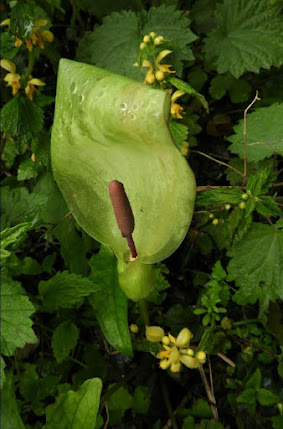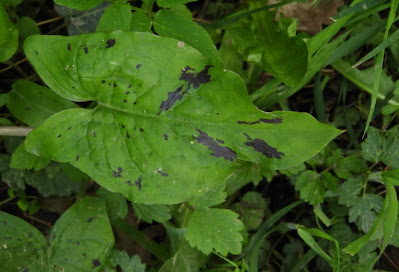Wordsworth wrote:
What we need is not the will to believe, but the wish to find out.
That seems a good note to start upon.
Lords-and-Ladies or Cuckoo-pint or Jack-in-the-pulpit has very many local names, bringing home the usefulness of the Latin: Arum maculatum. There are only two Arum species found in the UK: Arum maculatum and Arum italicum which is native locally on the South Coast. Arum italicum is much more widespread as a garden escapee.
Richard Mabey in Flora Britannica writes " the plant itself is a handsome and modest one, pale and sculptural in the spring." I won't argue with that.
These Long purples may be Early-purple Orchid, Orchis mascula (another story there) but as Arum maculatum is known as Dead Man's Fingers in Worcestershire I think there is room for doubt. Of course, if Shakespeare had used the Latin names we wouldn't be in any doubt!
One of the hundred plus folk names is Starchwort. Gerard records that a pure and white starch is made from the roots of Cuckoo-pint. It was used for stiffening Elizabethan ruffs but as it was acrid it was very damaging to the hands of those doing the starching.
Richard Mabey reports from E. M Porter's book Cambridgeshire Customs and Folklore (1969) that the pollen of this flower throws off a faint light at dusk and when Irish labourers came to the Fens to find work they named the plant Fairy Lamps. Fen lightermen had long called them Shiners. (Memo to self: go and have a look!)
The botanical structure is fascinating and grows more at every turn. Below is my first sight of an opened spathe this year. The large, pale green hood surrounds the upright, pencil-like spadix which is between 10-25 cm tall. The spathe overlaps about 30% at the base which is one of the pollination devices, protecting the flowers and providing an insect trap: read on for details.
In my garden I found a plant that was at least approaching phase 2, probably on Day 2. The spathe had withered and I pulled it back to expose the small red spherules which are the male flowers and the cream globules that are the female ones. Some of the female flowers have hairs coming from them. A tiny slug remained but I think the midges had gone. The female flowers mature into the orange berries seen in the Autumn which are the most poisonous part of the plant.
Leaves might seem an anticlimax after all that but they have their own backstory of normal black spots due to a genetic factor and occurring on only some of Arum maculatum plants. I found these within a couple of metres of each other on the shady side of a hedgerow. One spotted, one not. And to further complicate the issue there are black spots caused by a Basidomycotal smut fungus..... Lots more info on the Wildflowerfinder website, link below.
Pythagoras said: "Leave the road, take the trails." I hope you have found this trail round the hedgerows and woods of Monmouthshire interesting.
Acknowledgements
Richard Mabey Flora Britannica
Harrap's Wildflowers
Clive Stace The New Flora of the British Isles 4
Grigson The Englishman's Flora
Websites included
https://bardgarden.blogspot.com/2015/01/ophelias-flowers.html
http://elsinore.ucsc.edu/women/longPurples.html
http://wildflowerfinder.org.uk/Flowers/L/LordsAndLadies/LordsAndLadies.htm
https://botanical.com/botanical/mgmh/c/cucko122.html







